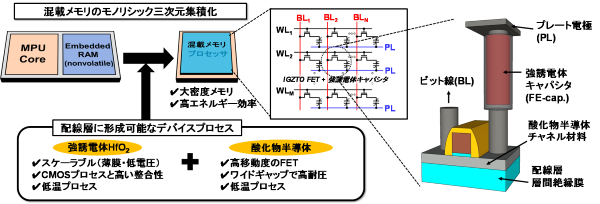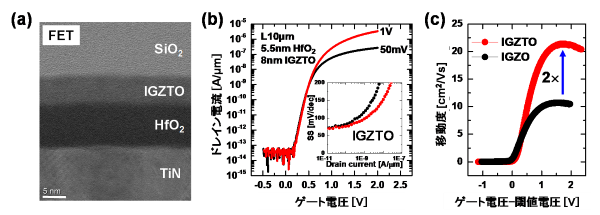

东京大学:开发3D集成内存:解决冯诺依曼瓶颈
-同时集成高迁移率晶体管和铁电电容器-
2021.06.01
东京大学和神户制钢:[新闻稿]
◆ 实现铁电电容器
使用添加了 Sn 的 IGZO 材料,
迁移率比以前高两倍多的晶体管,
我们已经实现了可以通过400°C以下的低温工艺形成的铁电电容器。
◆ 3D集成内存操作演示
高迁移率晶体管和
同时集成铁电电容器
我们已经成功地演示了可以在三个维度上集成的存储设备的操作。
◆ 在边缘设备上实施机器学习
有了这种存储设备技术
机器学习可以在边缘设备上实现,
预计使用人工智能开发更先进的社会服务。
东京大学小林副教授,
神户制钢,
神钢研究所,
开发的3D集成存储设备:
集成了一个使用 IGZO 并添加了 Sn 的晶体管和一个铁电 HfO2 电容器。
我们已成功开发出可嵌入处理器集成电路布线层的存储设备技术。
传统机器学习算法:
机器学习算法需要在大内存和处理器之间进行高效的数据传输。
但是,主存储器目前是在与处理器不同的芯片上实现的。
芯片间数据传输效率差,机器学习计算处理延迟。
这被称为冯诺依曼瓶颈。
解决冯诺依曼瓶颈:
为了同时实现大容量存储器和高效数据传输,可直接三维集成到处理器集成电路布线层的混合存储器件是一种有效的解决方案。
处理器布线层大容量内存:
我们在处理器的布线层上实现了可以三维集成的大容量内存。
可以直接连接在处理器上方
提高数据传输效率,
机器学习的高能效执行,
以上两点现在是可能的。
这次的成绩:
机器学习可以以高能效计算。
提高边缘设备的性能
通过在边缘设备上执行高级人工智能计算,预计大数据服务将得到显着改善。
东京大学产业科学研究所
https://www.iis.u-tokyo.ac.jp/ja/news/3569/
Closer hardware systems bring the future of artificial intelligence into view
Machine learning is the process by which computers adapt their responses without human intervention.
This form of artificial intelligence (AI)
is now common in everyday tools such as virtual assistants and is being developed for use in areas from medicine to agriculture.
A challenge posed by the rapid expansion of machine learning is the high energy demand of the complex computing processes.
Researchers from The University of Tokyo
have reported the first integration of a mobility-enhanced field-effect transistor (FET) and a ferroelectric capacitor (FE-CAP)
to bring the memory system into the proximity of a microprocessor and improve the efficiency of the data-intensive computing system.
Their findings were presented at the 2021 Symposium on VLSI Technology.
Memory cells require both a memory component and an access transistor.
In currently available examples, the access transistors are generally silicon-metal-oxide semiconductor FETs.
While the memory elements can be formed in the ‘back end of line’ (BEOL) layers,
the access transistors need to be formed in what are known as the ‘front end of line’ layers of the integrated circuit, which isn’t a good use of this space.
In contrast, oxide semiconductors such as indium gallium zinc oxide (IGZO)
can be included in BEOL layers because they can be processed at low temperatures.
By incorporating both the access transistor and the memory into a single monolith in the BEOL,
high-density, energy-efficient embedded memory can be achieved directly on a microprocessor.
The researchers
used IGZO doped with tin (IGZTO) for both the oxide semiconductor FET and ferroelectric capacitor (FE-cap) to create 3D embedded memory.
“The proximity achieved with our design will significantly reduce the distance that signals must travel, which will speed up learning and inference processes in AI computing, making them more energy efficient,”
study author Masaharu Kobayashi explains.
– Institute of Industrial Science, the University of Tokyo